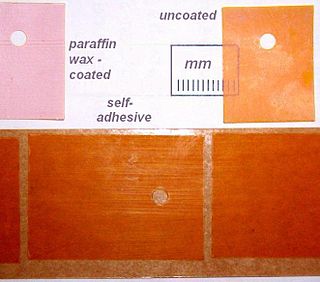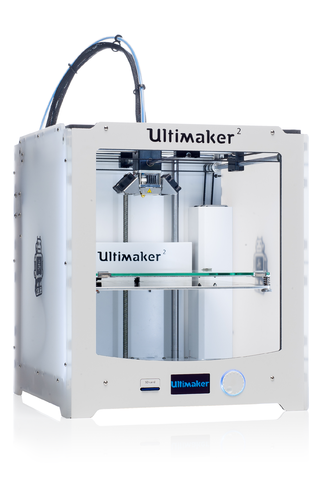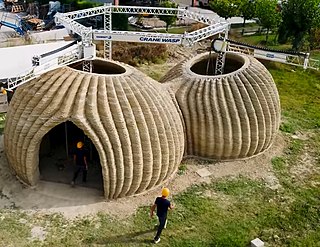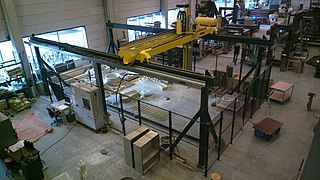Related Research Articles

The USC Viterbi School of Engineering is the engineering school of the University of Southern California. It was renamed following a $52 million donation by Andrew J. Viterbi, co-founder of Qualcomm.

Kapton is a polyimide film used in flexible printed circuits and space blankets, which are used on spacecraft, satellites, and various space instruments. Invented by the DuPont Corporation in the 1960s, Kapton remains stable across a wide range of temperatures, from 4 to 673 K. Kapton is used in electronics manufacturing, space applications, with x-ray equipment, and in 3D printing applications. Its favorable thermal properties and outgassing characteristics result in its regular use in cryogenic applications and in situations where high vacuum environments are experienced.

Stereolithography is a form of 3D printing technology used for creating models, prototypes, patterns, and production parts in a layer by layer fashion using photochemical processes by which light causes chemical monomers and oligomers to cross-link together to form polymers. Those polymers then make up the body of a three-dimensional solid. Research in the area had been conducted during the 1970s, but the term was coined by Chuck Hull in 1984 when he applied for a patent on the process, which was granted in 1986. Stereolithography can be used to create prototypes for products in development, medical models, and computer hardware, as well as in many other applications. While stereolithography is fast and can produce almost any design, it can be expensive.

3D printing or additive manufacturing is the construction of a three-dimensional object from a CAD model or a digital 3D model. It can be done in a variety of processes in which material is deposited, joined or solidified under computer control, with the material being added together, typically layer by layer.

Space manufacturing is the production of tangible goods beyond Earth. Since most production capabilities are limited to low Earth orbit, the term in-orbit manufacturing is also frequently used.

RepRap is a project to develop low-cost 3D printers that can print most of their own components. As open designs, all of the designs produced by the project are released under a free software license, the GNU General Public License.

Rapid prototyping is a group of techniques used to quickly fabricate a scale model of a physical part or assembly using three-dimensional computer aided design (CAD) data. Construction of the part or assembly is usually done using 3D printing or "additive layer manufacturing" technology.
Behrokh Khoshnevis is the President and CEO of Contour Crafting Corporation and the Louise L. Dunn Distinguished Professor of Engineering at the University of Southern California (USC), where he has affiliations with the Aerospace & Mechanical Engineering, Astronautics Engineering, Civil & Environmental Engineering and Industrial & Systems Engineering departments. He is the Director of the Center for Rapid Automated Fabrication Technologies (CRAFT) at USC. He is a Member of the National Academy of Engineering, a Fellow Member of the National Academy of Inventors and is a Fellow of the American Society for the Advancement of Science. He is also a Fellow member of the Society for Computer Simulation International, a Fellow member of the Institute of Industrial & Systems Engineering and a Fellow member of the Society of Manufacturing Engineers. He is also a NASA Innovative Advanced Concepts (NIAC) Fellow.
D-Shape is a large 3-dimensional printer that uses binder-jetting, a layer by layer printing process, to bind sand with an inorganic seawater and magnesium-based binder in order to create stone-like objects. Invented by Enrico Dini, founder of Monolite UK Ltd, the first model of the D-Shape printer used epoxy resin, commonly used as an adhesive in the construction of skis, cars, and airplanes, as a binder. Dini patented this model in 2006. After experiencing problems with the epoxy, Dini changed the binder to the current magnesium-based one and patented the printer again in September 2008. In the future, Dini aims to use the printer to create full-scale buildings.
Construction 3D Printing (c3Dp) or 3D construction Printing (3DCP) refers to various technologies that use 3D printing as a core method to fabricate buildings or construction components. Alternative terms for this process include "additive construction." "3D Concrete" refers to concrete extrusion technologies whereas Autonomous Robotic Construction System (ARCS), large-scale additive manufacturing (LSAM), or freeform construction (FC) refer to other sub-groups.

A Mars habitat is a hypothetical place where humans could live on Mars. Mars habitats would have to contend with surface conditions that include almost no oxygen in the air, extreme cold, low pressure, and high radiation. Alternatively, the habitat might be placed underground, which helps solve some problems but creates new difficulties.

Made In Space, Inc. (MIS) is an American company specializing in the engineering and manufacturing of three-dimensional printers for use in microgravity. Headquartered in Jacksonville, Florida, Made In Space's 3D printer was the first manufacturing device used in space.

In recent years, 3D printing has developed significantly and can now perform crucial roles in many applications, with the most common applications being manufacturing, medicine, architecture, custom art and design, and can vary from fully functional to purely aesthetic applications.

A variety of processes, equipment, and materials are used in the production of a three-dimensional object via additive manufacturing. 3D printing is also known as additive manufacturing, because the numerous available 3D printing process tend to be additive in nature, with a few key differences in the technologies and the materials used in this process.

The Swamp Works is a lean-development, rapid innovation environment at NASA's Kennedy Space Center. It was founded in 2012, when four laboratories in the Surface Systems Office were merged into an enlarged facility with a modified philosophy for rapid technology development. Those laboratories are the Granular Mechanics and Regolith Operations Lab, the Electrostatics and Surface Physics Lab, the Applied Chemistry Lab, and the Life Support and Habitation Systems (LSHS) team. The first two of these are located inside the main Swamp Works building, while the other two use the facility although their primary work is located elsewhere. The team developed the Swamp Works operating philosophy from Kelly Johnson's Skunk Works, including the "14 Rules of Management", from the NASA development shops of Wernher von Braun, and from the innovation culture of Silicon Valley. The team prototypes space technologies rapidly to learn early in the process how to write better requirements, enabling them to build better products, rapidly, and at reduced cost. It was named the Swamp Works for similarity with the Skunk Works and the Phantom Works, but branded by the widespread marshes (swamps) on the Cape Canaveral and Merritt Island property of the Kennedy Space Center. The Swamp Works was co-founded by NASA engineers and scientists Jack Fox, Rob Mueller, and Philip Metzger. The logo, a robotic alligator, was designed by Rosie Mueller, a professional designer and the spouse of Rob Mueller.

The Moon bears substantial natural resources which could be exploited in the future. Potential lunar resources may encompass processable materials such as volatiles and minerals, along with geologic structures such as lava tubes that, together, might enable lunar habitation. The use of resources on the Moon may provide a means of reducing the cost and risk of lunar exploration and beyond.

3D food printing is the process of manufacturing food products using a variety of additive manufacturing techniques. Most commonly, food grade syringes hold the printing material, which is then deposited through a food grade nozzle layer by layer. The most advanced 3D food printers have pre-loaded recipes on board and also allow the user to remotely design their food on their computers, phones or some IoT device. The food can be customized in shape, color, texture, flavor or nutrition, which makes it very useful in various fields such as space exploration and healthcare.
Mahta Moghaddam is an Iranian-American electrical and computer engineer and William M. Hogue Professor of Electrical Engineering in the Ming Hsieh Department of Electrical and Computer Engineering at the University of Southern California Viterbi School of Engineering. Moghaddam is also the president of the IEEE Antennas and Propagation Society and is known for developing sensor systems and algorithms for high-resolution characterization of the environment to quantify the effects of climate change. She also has developed innovative tools using microwave technology to visualize biological structures and target them in real-time with high-power focused microwave ablation.

The Tecla house is a prototype 3D-printed eco residential building made out of clay. The first model was designed by the Italian architecture studio Mario Cucinella Architects (MCA) and engineered and built by Italian 3D printing specialists WASP by April 2021, becoming the world's first house 3D-printed entirely from a mixture made from mainly local earth and water. Its name is a portmanteau of "technology" and "clay" and that of one of Italo Calvino's Invisible Cities whose construction never ceases.

3D concrete printing, or simply concrete printing, refers to digital fabrication processes for cementitious materials based on one of several different 3D printing technologies. 3D printed concrete eliminates the need for formwork, reducing material waste and allowing for greater geometric freedom in complex structures. With recent developments in mix design and 3D printing technology over the last decade, 3D concrete printing has grown exponentially since its emergence in the 1990s. Architectural and structural applications of 3D-printed concrete include the production of building blocks, building modules, street furniture, pedestrian bridges, and low-rise residential structures.
References
- ↑ "Annenberg Foundation Puts Robotic Disaster Rebuilding Technology on Fast Track". University of Southern California School of Engineering. November 14, 2005. Retrieved May 8, 2012.
- ↑ "Automated Construction using Contour Crafting – Applications on Earth and Beyond" (PDF). Archived from the original (PDF) on October 21, 2014.
- ↑ "Caterpillar Inc. Funds Viterbi 'Print-a-House' Construction Technology". USC – Viterbi School of Engineering. August 28, 2008. Archived from the original on October 10, 2021. Retrieved January 13, 2010.
- ↑ "Singularity University Semester Completion and Projects". NextBigFuture. August 28, 2009. Retrieved October 21, 2014.
- ↑ "Home, Sweet Home". University of Southern California. March 24, 2004. Archived from the original on February 25, 2010. Retrieved January 13, 2010.
- ↑ "Green Building and Development" (PDF). Virginia Tech University. Retrieved May 2, 2023.
- ↑ Gabriel Fernandes; Lucas Feitosa (August 26, 2015). "Impact of Contour Crafting on Civil Engineering". International Journal of Engineering Research & Technology (IJERT). 4 (8). Retrieved May 2, 2023.
- ↑ "Colloquium with Behrokh Khoshnevis". Massachusetts Institute of Technology. Archived from the original on July 18, 2013. Retrieved January 13, 2010.
- ↑ "NASA's plan to build homes on the Moon: Space agency backs 3D print technology which could build base". TechFlesh. January 15, 2014. Archived from the original on January 16, 2014. Retrieved January 16, 2014.
- ↑ "New Press Release - CC-Corp". CC-Corp. June 8, 2017. Archived from the original on February 3, 2020. Retrieved September 14, 2017.